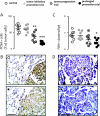Neutralization of tumor necrosis factor bioactivity ameliorates urethane-induced pulmonary oncogenesis in mice
- PMID: 22241960
- PMCID: PMC3257189
- DOI: 10.1593/neo.111224
Neutralization of tumor necrosis factor bioactivity ameliorates urethane-induced pulmonary oncogenesis in mice
Abstract
Tumor necrosis factor (TNF) has been implicated in inflammation-associated tumor progression. Although multiple reports identified a role for TNF signaling in established cancers, few studies have assessed the impact of TNF blockade on early tumor formation promotion. We aimed at exploring the effects of TNF neutralization in a preclinical mouse model of lung carcinogenesis. For this, Balb/c mice (n = 42) received four weekly intraperitoneal urethane injections (1 g/kg) and twice-weekly intraperitoneal soluble TNF receptor (etanercept; 10 mg/kg) administered during tumor initiation/promotion, tumor progression, or continuously (months 1, 6, and 1-8 after urethane start, respectively). Lung oncogenesis was assessed after 8 months. In separate short-term studies, Balb/c mice (n = 21) received a single control or urethane injection followed by twice-weekly intraperitoneal control or sTNFR:Fc injections. Lung inflammation was assessed after 1 week. We found that sTNFR:Fc treatment during tumor initiation/promotion resulted in a significant reduction of tumor number but not dimensions. However, sTNFR:Fc administered during tumor progression did not impact tumor multiplicity but significantly decreased tumor diameter. Continued sTNFR:Fc administration was effective in halting both respiratory tumor formation and progression in response to urethane. This favorable impact was associated with impaired cellular proliferation and new vessel formation in lung tumors. In addition, TNF neutralization altered the lung inflammatory response to urethane, evidenced by reductions in TNF and macrophage and increases in interferon γ and interleukin 10 content of the air spaces. sTNFR:Fc treatment of RAW264.7 macrophages downregulated TNF and enhanced interferon γ and interleukin 10 expression. In conclusion, TNF neutralization is effective against urethane-induced lung oncogenesis in mice and could present a lung chemoprevention strategy worth testing clinically.
Figures






References
-
- Ferlay J, Shin HR, Bray F, Forman D, Mathers CD, Parkin D. GLOBOCAN 2008, Cancer Incidence and Mortality Worldwide: IARC Cancer Base No. 10. Lyon, France: International Agency for Research on Cancer; 2010. [May 30, 2011]. Available at: http://globocan.iarc.fr.
-
- Jemal A, Bray F, Center MM, Ferlay J, Ward E, Forman D. Global cancer statistics. CA Cancer J Clin. 2011;61:69–90. - PubMed
-
- Alberg AJ, Ford JG, Samet JM. American College of Chest Physicians Epidemiology of lung cancer: ACCP evidence-based clinical practice guidelines (2nd edition) Chest. 2007;132:29S–55S. - PubMed
-
- Peto R, Lopez AD, Boreham J, Thun M. Mortality from Smoking in Developed Countries 1950–2000. Oxford, UK: Oxford University Press; 2006. [May 30, 2011]. Available at: http://www.ctsu.ox.ac.uk/~tobacco.
-
- Sun S, Schiller JH, Gazdar AF. Lung cancer in never smokers—a different disease. Nat Rev Cancer. 2007;7:778–790. - PubMed
Publication types
MeSH terms
Substances
Grants and funding
LinkOut - more resources
Full Text Sources
Medical
